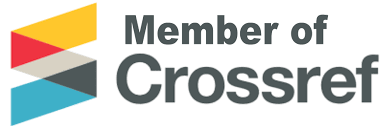Evaluation of Rental Flats Performance in Bandung City Based on Health Performance Indicators and Their Influence on Occupant Satisfaction
Abstract
Rental flat development is an alternative solution to solve the affordable housing problem in Indonesia’s big cities. Bandung City is one of the cities that really needs vertical residential development because it has a population of more than 2 million people and land availability is increasingly scarce. Apart from its basic function as a residence, flats must also have good health performance in order to fulfill all the aspects that residents need. This research aims to evaluate the performance of flats in Bandung City based on health performance indicators and their influence on occupant satisfaction. The assessment of flat health performance includes physical, mental, social, and managerial aspects. Descriptive research methods with qualitative and quantitative approaches were employed to evaluate the performance of the flats. Moreover, regression analysis was also carried out to determine the effect on resident satisfaction. The data collection techniques used were questionnaires, interviews, observation, and documentation studies. The results of the descriptive analysis show that flats in Bandung City have good health performance based on physical, mental, social, and managerial aspects. Furthermore, the variables that significantly influence occupant satisfaction are mental and managerial aspects. Meanwhile, the physical and social aspects have no significant influence on occupant satisfaction.
Keywords
Full Text:
PDFReferences
Afacan, Y. (2015). “Resident satisfaction for sustainable urban regenerationâ€. Proceedings of the Institution of Civil Engineers: Municipal Engineer, 168(4), 220–234. https://doi.org/10.1680/muen.14.00046
Ali, H. H., Almomani, H. M., & Hindeih, M. (2009). “Evaluating indoor environmental quality of public-school buildings in Jordanâ€. Indoor and Built Environment, 18(1), 66–76. https://doi.org/10.1177/1420326X08100760
Amerigo, M., & Aragones, J. I. (1997). “A theoretical and methodological approach to the study of residential satisfactionâ€. Journal of Environmental Psychology, 17(1), 47–57. https://doi.org/10.1006/jevp.1996.0038
Assarroudi, A., Heshmati Nabavi, F., Armat, M. R., Ebadi, A., & Vaismoradi, M. (2018). “Directed qualitative content analysis: the description and elaboration of its underpinning methods and data analysis processâ€. Journal of Research in Nursing, 23(1), 42–55. https://doi.org/10.1177/1744987117741667
Badan Pusat Statistik. (2020, September 17). Persentase Penduduk Daerah Perkotaan menurut Provinsi, 2010-2035. https://www.bps.go.id/statictable/2014/02/18/1276/persentase-penduduk-daerah-perkotaan-menurut-provinsi-2010-2035.html
Badan Pusat Statistik Kota Bandung. (2022). Kota Bandung Dalam Angka 2022.
Creswell, J. W. (2016). Research Design. Pendekatan metode Kualitatif, Kuantitatif, dan Campuran (Bahasa Indonesia). Penerbit Pustaka Pelajar.
Fraenkel, J. R., Wallen, N. E., & Hyun, H. H. (2012). How to Design and Evaluate Research in Education (8th ed.). Mc Graw Hill.
Hasan, A. (2014). Marketing dan Kasus-Kasus Pilihan (Vol. 2). Center for Academic Publishing Service.
Hidayati, N., & Susanto, A. (2018). “Residents’ satisfaction and loyalty in high-rise apartments: A study of Surabaya, Indonesiaâ€. Journal of Engineering and Applied Science, 13(7), 1625–1629.
Husin, H. N., Nawawi, A. H., Ismail, F., & Khalil, N. (2015). “Correlation Analysis of Occupants’ Satisfaction and Safety Performance Level in Low-Cost Housingâ€. Procedia - Social and Behavioral Sciences, 168, 238–248. https://doi.org/10.1016/j.sbspro.2014.10.229
Idrus, N., & Ho, C. S. (2008). “Affordable and Quality Housing through the Low-Cost Housing Provision in Malaysiaâ€. Seminar of Sustainable Development and Governance.
Kang, N. N., Kim, J. T., & Lee, T. K. (2014). “A Study on the Healthy Housing Quality of Multi-family Attached House According to Dwelling Unit Ageâ€. Energy Procedia, 62, 595–602. https://doi.org/https://doi.org/10.1016/j.egypro.2014.12.422
Kang, N. N., Lee, T. K., & Kim, J. T. (2012). “Characteristics of the Quality of Korean High-Rise Apartments Using the Health Performance Indicatorâ€. Indoor and Built Environment, 22(1), 157–167. https://doi.org/10.1177/1420326X12470344
Kementerian PUPR. (2022, February 25). Kurangi Backlog Hunian Layak, Kementerian PUPR Siapkan Grand Design Perumahan Segmen MBR Informal. https://pu.go.id/berita/kurangi-backlog-hunian-layak-kementerian-pupr-siapkan-grand-design-perumahan-segmen-mbr-informal
Keppres 22/06. Keputusan Presiden Republik Indonesia Nomor 22 Tahun 2006 Tentang Tim Koordinasi Percepatan Pembangunan Rumah Susun Di Kawasan Perkotaan.
Makalew, F. P., Waney, E. V. Y., Runtunuwu, S., & Mandang, D. J. F. (2021). “Ketersediaan Infrastruktur Kawasan Perumahan Sederhana (Studi Kasus: Perumahan Politeknik Indah)â€. Jurnal Manajemen Aset Infrastruktur & Fasilitas, 5(3), 289–300.
Mohit, M. A., & Azim, M. (2012). “Assessment of Residential Satisfaction with Public Housing in Hulhumale’, Maldivesâ€. Procedia - Social and Behavioral Sciences, 50, 756–770. https://doi.org/https://doi.org/10.1016/j.sbspro.2012.08.078
Nandi, & Dewiyanti, V. R. (2019). “Urban Sprawl Development in Eastern Bandung Regionâ€. IOP Conference Series: Earth and Environmental Science, 286(1), 012031. https://doi.org/10.1088/1755-1315/286/1/012031
Purnamasari, A. W., Soemitro, R. A. A., & Suprayitno, H. (2020). “Perbandingan Pengelolaan Rusunawa: Pemilik, Penghuni, Pengelola, Pembiayaan, Luas Unit, Tarif dan Fasilitasâ€. Jurnal Manajemen Aset Infrastruktur & Fasilitas, 4(2), 167–182.
Sekaran, U. (2013). Research Methods for Business. Salemba Empat.
Simbolon, L. N. S. (2021). “Evaluasi Kinerja Bangunan Gedung Kementerian Pekerjaan Umum dan Perumahan Rakyatâ€. Jurnal Manajemen Aset Infrastruktur & Fasilitas, 5(2), 147–160.
Sriyanto, A., & Nurhayati, Y. (2017). “Analisis Faktor-Faktor Yang Mempengaruhi Kepuasan Penghuni Apartemen (Studi Kasus Pada Apartemen Thamrin Residence Jakarta Pusat Melalui Jasa PT Jones Kreatif Properti)â€. Jurnal Ekonomika Dan Manajemen, 6(2).
Sugiyono. (2012). Metode Penelitian Bisnis. PT Alfabet.
Sugiyono. (2016). Metode Penelitian Kuantitatif, Kualitatif, dan R&D. PT Alfabet.
UU 20/11. Undang Undang No.20 Tahun 2011 tentang Rumah Susun.
Yu, C. W. F., & Jeong, T. K. (2011). â€Holistic healthy building for human habitatâ€. Indoor and Built Environment (Vol. 20, Issue 1, pp. 3–4). https://doi.org/10.1177/1420326X10397779
DOI: https://doi.org/10.35314/inovbiz.v11i2.3634
Refbacks
- There are currently no refbacks.
Copyright (c) 2024 Gilang Ramadhan, Tiafahmi Angestiwi, Tiafahmi Angestiwi

This work is licensed under a Creative Commons Attribution-NonCommercial-ShareAlike 4.0 International License.
This Journal has been listed and indexed in :
Copyright of Jurnal Inovasi Bisnis (p-ISSN : 2338-4840, e-ISSN : 2614-6983)

Inovbiz: Jurnal Inovasi Bisnis is licensed under a Creative Commons Attribution-NonCommercial-ShareAlike 4.0 International License.
Editorial Office :
Pusat Penelitian dan Pengabdian kepada Masyarakat
 Politeknik Negeri BengkalisÂ
Jl. Bathin alam, Sungai Alam Bengkalis-Riau 28711Â
E-mail: inovbiz@polbeng.ac.id














